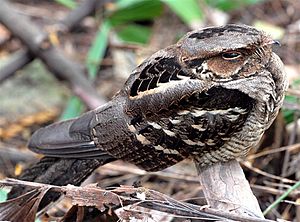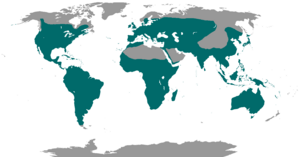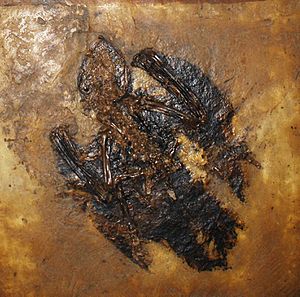Caprimulgiformes facts for kids
Quick facts for kids CaprimulgiformesTemporal range: Middle Paleocene to present
|
|
|---|---|
 |
|
| Large-tailed nightjar, Caprimulgus macrurus | |
| Scientific classification |
|
| Kingdom: | Animalia |
| Phylum: | Chordata |
| Class: | Aves |
| Clade: | Strisores |
| Order: | Caprimulgiformes Ridgway, 1881 |
| Families | |
Families also placed in Apodiformes |
|
 |
|
| Global distribution of the nightjar and allies | |
The Caprimulgiformes is a group, or order, of birds. You can find these birds all over the world, except in Antarctica. They mostly eat insects and are active at night, which means they are nocturnal.
The name "Caprimulgiformes" comes from Latin words meaning "goat-milker." This old name came from a mistaken idea about how the European nightjar used to feed. This group of birds, along with some others like swifts and hummingbirds, is also known as Strisores.
Contents
What Are Caprimulgiformes?
Scientists group living things into different categories to understand how they are related. The Caprimulgiformes order includes several interesting bird families. These families are often grouped together because they share similar features and a common ancestor.
Here are some of the bird families that belong to the Caprimulgiformes order:
- Family Trochilidae (hummingbirds, about 368 species)
- Family Apodidae (swifts, about 96 species)
- Family Caprimulgidae (nightjars, about 98 species)
- Family Podargidae (frogmouths, about 14 species)
- Family Aegothelidae (owlet-nightjars, about 10 species)
- Family Nyctibiidae (potoos, about 7 species)
- Family Hemiprocnidae (treeswifts, about 4 species)
- Family Steatornithidae (oilbird, 1 species)
How Scientists Group These Birds
For a long time, it was hard for scientists to agree on how to classify these birds. Some birds, like nightjars, were thought to be separate from others, like swifts and hummingbirds. However, new studies using DNA have helped scientists understand their relationships better.
Today, many scientists agree that all these families are closely related. They form a larger group called Strisores. This means that hummingbirds, swifts, nightjars, and others are all part of the same big family tree.
Scientists use special diagrams called cladograms to show how different species are related. These diagrams look like branching trees. The branches show how species evolved from common ancestors.
Here is one way scientists think these birds are related, based on recent DNA studies:
| Caprimulgiformes |
|
||||||||||||||||||||||||||||||||||||||||||
How Caprimulgiformes Evolved
Scientists learn about the history of these birds by studying fossils. Fossils are the preserved remains of ancient living things. There are many fossils of Caprimulgiform birds, which helps scientists understand their past.
One important fossil is a bird called Paraprefica. This bird lived a very long time ago, possibly in the Early Eocene epoch. It seems to be an early form of these birds, showing how they might have first appeared.
Fossils suggest that the main groups of these birds started to separate around 60 to 55 million years ago. This was during a time called the Paleogene period. Later, around 40 million years ago, the ancestors of nightjars and potoos separated from the ancestors of oilbirds and frogmouths.
How Caprimulgiformes Reproduce
Caprimulgiform birds usually lay only a few eggs at a time. For example, frogmouths and potoos often lay just one egg. Nightjars usually lay one or two eggs, and the Oilbird typically lays three.
Most of these birds do not build a fancy nest. Instead, they lay their eggs directly on the ground or on tree branches. The Oilbird is different because it nests in groups inside tree hollows.
Both parent birds usually help to keep the eggs warm until they hatch. The baby birds, called chicks, are covered in soft down feathers when they hatch. They are often white, which helps them blend in with the eggs and stay hidden from predators.
Not much is known about how long many of these birds live or when they first start to breed. Most Caprimulgiform birds stay with the same partner for many years. They are usually monogamous. Only the eared nightjars typically have more than one group of babies in a year.
Images for kids
See also
 In Spanish: Chotacabras para niños
In Spanish: Chotacabras para niños







